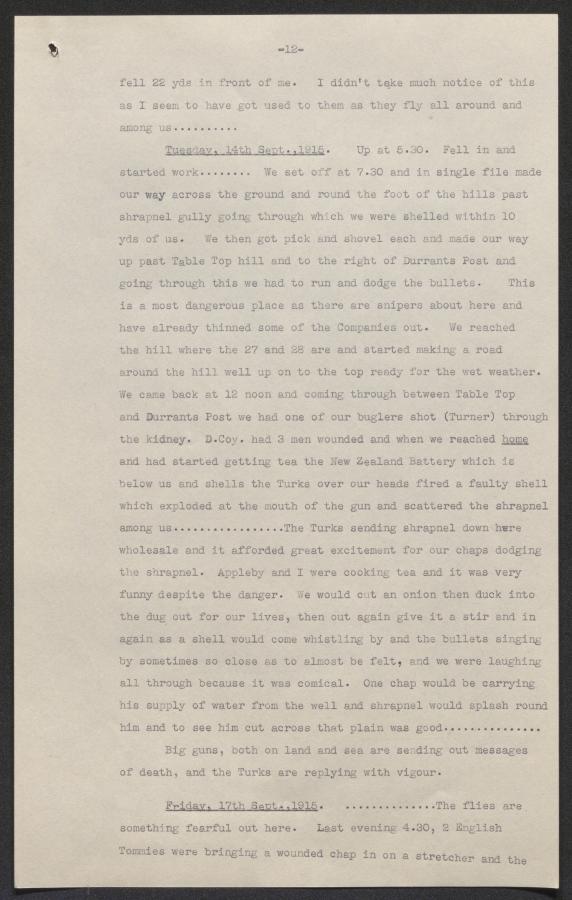From Gallipoli to the Western Front: the Diary of Lieutenant William Grubb
Private William Edward Kemp Grubb of Launceston, Tasmania was 25 years old when he and the newly-formed 26th Battalion embarked for Gallipoli on 29 June 1915. From the moment he embarked, he kept a deeply thoughtful record of his life as a soldier in the First World War, with his diaries spanning his service from 1915 to 1918. William’s diaries bring us into the emotional world of an idealistic young soldier as he grapples with the gruelling and often vicious realities of war.
The 26th Battalion was met with gunfire as it landed at Anzac Cove on 12 September 1915. William recalled, “the bullets dropped around us, but not a man was hit.” Told on the troopship that he would be made lance corporal, William’s bravery and perseverance was immediately put to the test. On one of his first mornings on the front he recorded, “the scent of new slain dead was in the air and I walked on something squashy. I kept my eyes ahead and tried to think of things less gruesome.” Like many others, William used humour to keep up morale. “It was very funny despite the danger,” he wrote, describing his attempts to cook a meal while under fire; “we would cut an onion and then duck into the dug out for our lives, then out again give it a stir and in again as a shell would come whistling by … and we were laughing all through because it was comical.”

Diary of Lieutenant William Edward Kemp Grubb pg. 15. 2DRL/1110
Within a month of his arrival at Gallipoli, William was stricken with enteric fever, also known as typhoid, with typical symptoms including aches and pains, fever and fatigue. Unsanitary conditions at Gallipoli meant that gastrointestinal illness was common. All around him, William saw the devastation caused by illness: “I have seen men here big and strong and healthy one day and in a week’s time they have been ‘walking skeletons’”. As other soldiers deteriorated before his eyes, William began to fear for his older brother, Francis, who had enlisted in August 1915 at the age of 27: “God help Frank if he ever gets here. He is very delicate and less able to stand these things than I.” William, however, was resolute. “Today I have been ill all day and working just the same,” he wrote. His determination to press on regardless of the pain and fatigue he undoubtedly felt was a mark of his character. It was this spirit of perseverance that his fellow soldiers would later remember him for.
Despite William’s determination, a breaking point eventually came. In his own words, “I got so ill that I could keep up no longer.” He was evacuated to No. 13 Casualty Clearing Station on Anzac Beach. Far from a peaceful respite, the makeshift hospital was often rocked by exploding shells, and peppered with shrapnel and stray bullets. Within his first days at the clearing station, two men died and others were wounded in the crossfire. In his diary, William remarked “we made up our minds that instead of coming here to be cured we stood a fair chance of being killed.”

No. 13 Casualty Clearing Station on Anzac Beach, c. 1915. Photographer unknown. H00288
In January 1916, William boarded the troopship Commonwealth and returned to Australia. While he convalesced at home in Tasmania, his worst fears for his brother were tragically confirmed. Frank was killed in action at the battle of Pozières on 25 July 1916.
William returned to war the following year, embarking on 10 February 1917. Arriving on the Western Front as a lieutenant of the 40th Battalion he adapted to a new theatre of war, bearing the responsibility of commanding men through bloody fighting in Belgium and France. William saw with his own eyes the horrific trench warfare that had claimed the life of his brother Frank months earlier. “I have never been under such shelling before and never want to again,” he scrawled in his diary as he sheltered in a trench on 21 February 1918. In that same entry just a few lines later, he wrote “I have just been driven out of my dug out by a shell which landed almost on top of it had exploded would probably have ended this diary here.”

Diary of Lieutenant William Edward Kemp Grubb pg. 29. 2DRL/1110
On 28 March 1918, Lieutenant William Edward Kemp Grubb was killed in action near Morlancourt. He was 27 years old. Private J.R. Beams reported that William “had been wounded about an hour before [he was killed],” but had “pluckily insisted on remaining with the boys, carrying on.”
William’s diaries can be viewed in the Charles Bean Research Centre. They are in the process of being digitised and will display online in coming months.